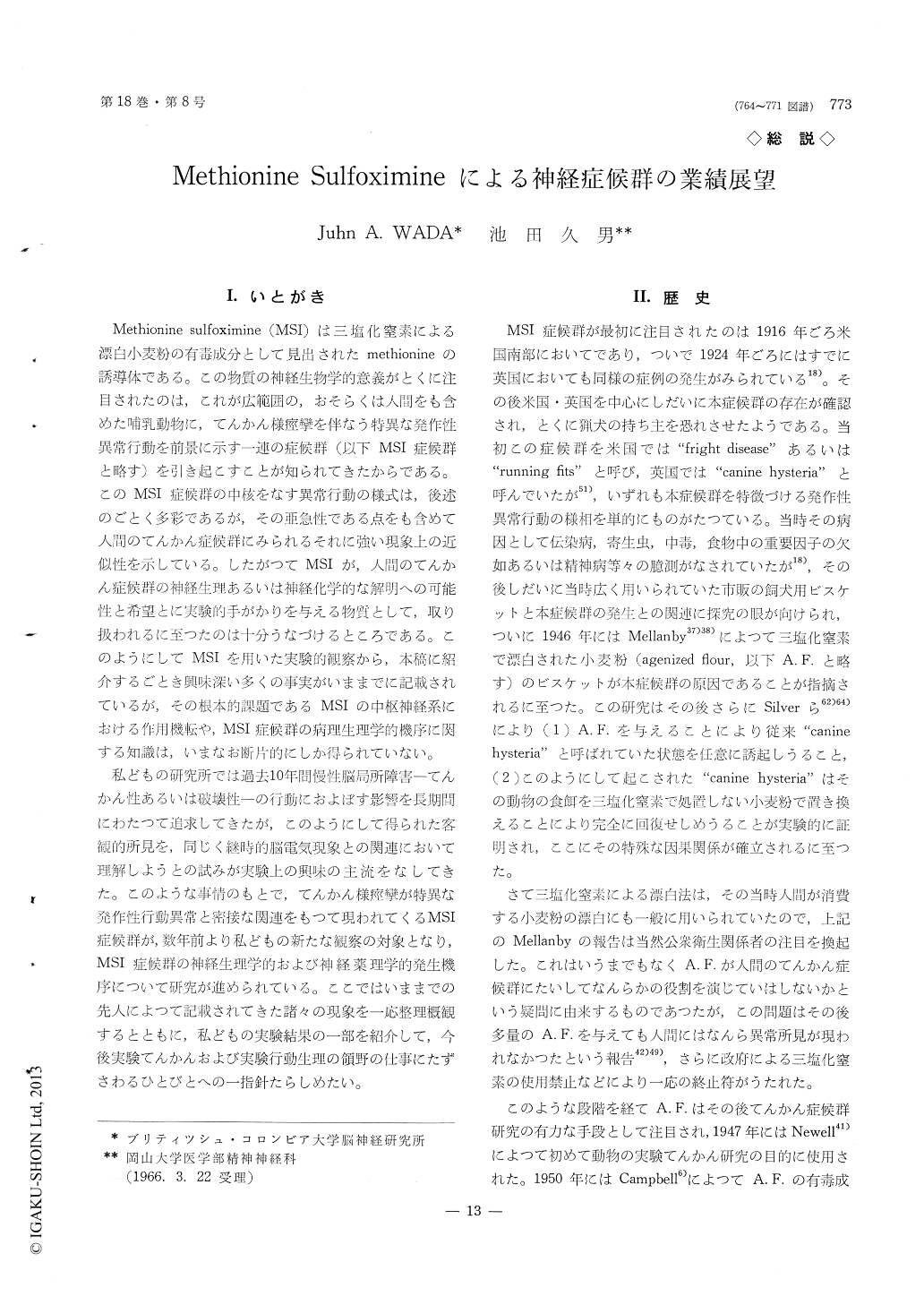Japanese
English
- 有料閲覧
- Abstract 文献概要
- 1ページ目 Look Inside
I.いとがき
Methionine sulfoximine (MSI)は三塩化窒素による漂白小麦粉の有毒成分として見出されたmethionineの誘導体である。この物質の神経生物学的意義がとくに注目されたのは,これが広範囲の,おそらくは人間をも含めた哺乳動物に,てんかん様痙攣を伴なう特異な発作性異常行動を前景に示す一連の症候群(以下MSI症候群と略す)を引き起こすことが知られてきたからである。このMSI症候群の中核をなす異常行動の様式は,後述のごとく多彩であるが,その亜急性である点をも含めて人間のてんかん症候群にみられるそれに強い現象上の近似性を示している。したがつてMSIが,人間のてんかん症候群の神経生理あるいは神経化学的な解明への可能性と希望とに実験的手がかりを与える物質として,取り扱われるに至つたのは十分うなづけるところである。このようにしてMSIを用いた実験的観察から,本稿に紹介するごとき興味深い多くの事実がいままでに記載されているが,その根本的課題であるMSIの中枢神経系における作用機転や,MSI症候群の病理生還学的機序に関する知識は,いまなお断片的にしか得られていない。
私どもの研究所では過去10年問慢性脳局所障害—てんかん性あるいは破壊性—の行動におよぼす影響を長期間にわたつて追求してきたが,このようにして得られた客観的所見を,同じく継時的脳電気現象との関連において理解しようとの試みが実験底上の興味の主流をなしてきた。このような事情のもとで,てんかん様痙攣が特異な発作性行動異常と密接な関連をもつて現われてくるMSI症候群が,数年前より私どもの新たな観察の対象となり,MSI症候群の神経生理学的および神経薬理学的発生機序について研究が進められている。ここではいままでの先人によつて記載されてきた諸々の現象を一応整理概観するとともに,私どもの実験結果の一部を紹介して,今後実験てんかんおよび実験行動生理の領野の仕事にたずさわるひとびとへの一指針たらしめたい。
Methionine sulfoximine is the principal toxic agent responsible for the peculiar behavioral which were prevalent among domestic dogs maintained on dog biscuit made of agenized flour at the turn of this century. This behavior had been known to be cha-racterized by a variety ofcolorful episodic events eventually leading to wild running and generalized convulsions. Although this peculial behavioral ma-nifestation had been variously called as hysteria, fright or psychomotor epilepsy in the past, the exact natur of the underlying neurobiological mechanism remained obscure.
In an attempt to gain insight into this problem, the authors have reviewed the relevant literature of the past with respect to behavioral manifestations, neurophysiological and biochemical correlates, as well as pathological consequences, and added some of the authors' own experiences in this area, including (1) a precise description and fractionation of episodic as well as background behavioral components, (2) the dis-closure of an entirely reversible nature, behaviorally and histologically, of the methionine sulfoximine synd-rome, (3) the revelation of audiogenic susceptibility of certain episodic behavioral components and their striking similarity to those of genetically determined audiogenic sensitive animali, and, finally, (4) the correlation of behavioral and brain electrical events following modification of brain of catecholamines, serotonin and acetylcholine. The significance of these findings is discussed in terms of possible directions that future investigations may take in order to throw light on this problem.

Copyright © 1966, Igaku-Shoin Ltd. All rights reserved.


